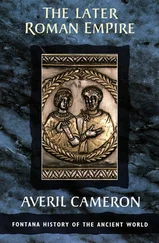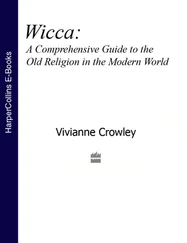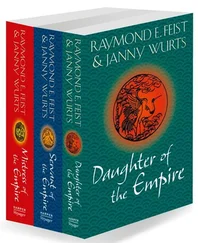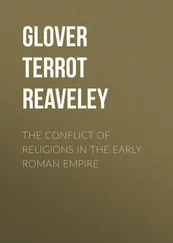Religion in the Roman Empire
Здесь есть возможность читать онлайн «Religion in the Roman Empire» — ознакомительный отрывок электронной книги совершенно бесплатно, а после прочтения отрывка купить полную версию. В некоторых случаях можно слушать аудио, скачать через торрент в формате fb2 и присутствует краткое содержание. Жанр: unrecognised, на английском языке. Описание произведения, (предисловие) а так же отзывы посетителей доступны на портале библиотеки ЛибКат.
- Название:Religion in the Roman Empire
- Автор:
- Жанр:
- Год:неизвестен
- ISBN:нет данных
- Рейтинг книги:5 / 5. Голосов: 1
-
Избранное:Добавить в избранное
- Отзывы:
-
Ваша оценка:
- 100
- 1
- 2
- 3
- 4
- 5
Religion in the Roman Empire: краткое содержание, описание и аннотация
Предлагаем к чтению аннотацию, описание, краткое содержание или предисловие (зависит от того, что написал сам автор книги «Religion in the Roman Empire»). Если вы не нашли необходимую информацию о книге — напишите в комментариях, мы постараемся отыскать её.
This volume provides a compelling view of central aspects of cult and religion in the Roman Empire, among them the distinction between public and private cult, the complex interrelations between different religious traditions, their mutually entangled developments and expansions, and the diversity of regional differences, rituals, religious texts and artefacts.
Religion in the Roman Empire — читать онлайн ознакомительный отрывок
Ниже представлен текст книги, разбитый по страницам. Система сохранения места последней прочитанной страницы, позволяет с удобством читать онлайн бесплатно книгу «Religion in the Roman Empire», без необходимости каждый раз заново искать на чём Вы остановились. Поставьте закладку, и сможете в любой момент перейти на страницу, на которой закончили чтение.
Интервал:
Закладка:
It often becomes clear to us through such evidence that the focus on a cult could be driven by either groups or even by individuals. This adds another level of complexity to our struggle for understanding sanctuaries as shared spaces. If groups or individuals could take charge and drive the way in which sacred spaces—in- and outside cities—were located and upkept and how religious life therefore was practiced, then we must consider whether the presence of particular agents might have been what drove religious life more, than an overall societal engagement in such matters. Sanctuaries were places where euergetism was fully lived and thus the intersection between doing good for the public and at the same time forcing religious practices would in some cases have been deeply intertwined; the public and the religious spheres became intersecting realms, which could not be completely separated.
Sanctuaries of the Roman period across the Roman Empire were spaces, which embraced multiple realities of which we might only see a few represented in the evidence that we have today, and we therefore have to stay alert to the various other realms, which might be invisible to us.
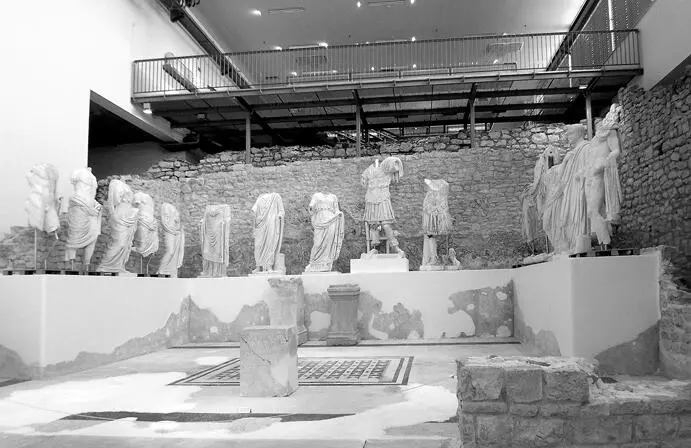
Fig. 13:The building for the worship of the imperial family in Narona (Croatia), erected around 10 B.C., with marble statues of members of the Julio-Claudian to Flavian dynasty (1st century A.D.). (Rolf Kawel, CC BY-SA 3.0).
2 The role of sanctuaries in an empire full of differences
The local traditions, gods, rituals, the relationship between divine and human actors—in short, the diversity of micro-regional elements, socio-cultural groups and religious customs—grew in the first centuries A.D. with the expansion of the Roman Empire. However, a religion from above, a state-controlled religious practice in the strict sense did not exist from the beginning, and would certainly not have had a future for a growing community that tried to bring such different traditions, habits, languages and people under one administrative and political roof. 33In the course of the conquests by Rome in the 3rd to 1st centuries B.C., there were no comprehensive measures in the newly created provinces—neither by the new rulers nor the old elites—to spread in a quasi-missionary manner new deities and places where they were worshipped. Yet, changes, which gods were worshipped or shifts in the spatial design of sanctuaries, and other, often small developments reflect the changed socio-political conditions. Even the Christian religion, which is often regarded as the religion of the Empire, cannot be described as such before the 5th/6th century A.D.
Nonetheless the first centuries A.D. demonstrate a rise in evidence, inscriptions in particular, which tell us about how rituals were to be performed 34and how people needed to behave in order to conduct offerings and other religious acts. The growing diversity, the—sometimes—fast spread of cults, and the adaptability of local societies also called for a higher degree of regulation and description of how to perform rituals correctly and worship the gods in the way that was defined as correct. The increasing interconnectivity between regions, often located far from each other, gave rise to the need for formalising ritual practice through written texts and inscriptions, and most likely also through religious practices and performances. So while no »Reichsreligion« existed, an underlining of the importance of performing religion in the correct way increased. This certainly shows that religion obviously also could be performed in what was perceived as a wrong way. However, such evidence is hardly ever passed on to us, since the enticement to record failed religious practice would not have been high.
Sanctuaries as places where people came together for individual or collective rituals, where memories of groups and different actors gathered, where younger generations acquired identity and self-understanding and where life was regulated with the help of the gods, reflect how a society changed and how its global contexts (in the case of the Roman Mediterranean Empire extending both east and south) shifted. Changes resulted from the development of socio-cultural groups, places and regions that became part of the Roman Empire. Often the local social and economic elites, but also traders and peasants or members of the military were the carriers of change. This plethora of individuals and groups could add to the religious life of a society and furthermore give insight into the complexities of religious life also as it must have been performed in the sanctuaries. In Palmyra, we know that the main sanctuaries of the city, at least both the Sanctuary of Bel and that of Baalshamin, at different points in time were occupied by different groups of priests and even individual priests, who through the financing of religious banquets appropriated these central and important religious spaces at least at a certain point in time. 35At other sanctuaries we also know of groups financing festivals and processions and through such activities claiming ownership of a certain religious activity.
How actively and consciously people pushed developments forward, e.g. by accepting more gods or changing religious customs and rituals, varied. Local interests and circumstances, political circumstances or the individual ideas of religious specialists in the cities and regions could be decisive here. 36
The countless landscapes, places and inhabitants that had gradually come under Roman administration (Sicilia, Sardinia, Hispania, Africa, Asia, Graecia) during the time of the Roman Republic on the Italian peninsula and around the Mediterranean brought together great differences not only in languages and economic bases, but also in dedication practice and figures of the gods. According to the Roman-Latin attribution of names to ethnic groups, it was Oscans and Samnites in Campania, Lucanians and Daunians in Puglia and Lucania, Volsicans, Aequans and Marsians in the Abruzzo, as well as Picenians and Umbrians, Etruscans and Celts in the northern parts of the peninsula who made up the diversity. 37The Greek-Punic roots of the southern and western provinces also brought conditions for relations and exchanges with them. People with Italian-Latin roots, Romans and Latins with their concepts of deities and places of worship came into contact with sanctuaries of a completely different design, which, for example followed Punic, Near Eastern or Celtic traditions (Africa, Gallia, Hispania). 38
Growing attention to binding gods to places can be noted as an important driver in the development of local religious life. At Gerasa, the Roman period gives us evidence of the city’s society creating their own unique Tyche, namely the Artemis-Tyche-of the Gerasenes, who is mentioned on coins from the 2nd century A.D. onward. 39In this way local societies claimed their gods as belonging to their physical spaces and the elaboration of the physical sanctuary spaces was another way of underlining such belonging through monumentality and visibility in the urban fabric, and also often on the civic city coins, which were the mass media most broadly circulated in this period, and which would have reached beyond the city’s own territory and alerted outsiders to the religious topography/ies of the given city. Sanctuaries and deities of cities were often depicted on coins in this period. 40
Sanctuaries, which had a certain fame and material wealth, 41ran the risk in this period when the Roman Empire expanded rapidly that Roman commanders took statuary or other valuable objects as booty for their legions and for their reputation, which could be enhanced by showing the objects during the triumphal processions in Rome. 42This procedure literally left some holy places in Greece (Delphi, Athens, Epidauros) or in Lower Italy and Sicily (Taranto) empty, since sanctuary furnishings were brought to Rome as symbols of victory and dominance in order to decorate Roman temples before the eyes of the Roman population. The triumphator was able to build a new temple with the money from the spoils and set it up in gratitude towards the gods to whom he often had pledged a personal connection. Q. Lutatius Catulus who offered a temple to Fortuna huisuque diei is one example of an individual using sacred spoils to further his own relations with the Roman gods. 43Or the commander had an already existing temple re-equipped, such as the temple for Apollo Sosianus, where classical, i.e. centuries-old, sculptures from an Apollo temple in Eretria in Greece decorated the pediment. 44This looted sacred art was used to negotiate the Roman religious values, demonstrate superiority and show respect for the Roman gods; at the same time, these newly laid out or furnished sanctuaries in Rome were places where the identity of the Romans was realigned, adapting to a growing empire and new influences. The general Lucullus (Felicitas sanctuary) as well as Fulvius Nobilior (Hercules Musagetes) donated temples surrounded by porticoes in Rome in order to set up sculptures of deities which they had carried with them in their triumphs. 45An action in the opposite direction could then be a return, as Augustus arranged for it, in order to give back the property of the gods to the sites of Asia Minor. 46
Читать дальшеИнтервал:
Закладка:
Похожие книги на «Religion in the Roman Empire»
Представляем Вашему вниманию похожие книги на «Religion in the Roman Empire» списком для выбора. Мы отобрали схожую по названию и смыслу литературу в надежде предоставить читателям больше вариантов отыскать новые, интересные, ещё непрочитанные произведения.
Обсуждение, отзывы о книге «Religion in the Roman Empire» и просто собственные мнения читателей. Оставьте ваши комментарии, напишите, что Вы думаете о произведении, его смысле или главных героях. Укажите что конкретно понравилось, а что нет, и почему Вы так считаете.




